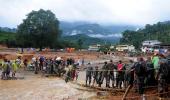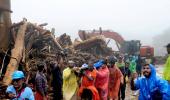'It was a war-like situation, but instead of enemy fire, we fought against the vagaries of nature,' says Major Seeta Shelke.

After suffering days of death, destruction and loss, there was something for the people of Wayanad to cheer about -- something to be grateful for.
In the school compound, locals had made a human chain to give a warm farewell to the departing last columns of the Indian Army that had come to help them in their darkest moments.
Nearly 400 people died in consecutive landslides that struck four villages within four hours on July 30.
The villages had been flattened, many lay buried or dead as they slept and the only bridge that provided access was washed away.
The raging Iruvazhinji river had overflown and swallowed the existing bridge cutting off Mundkkai village from the rest of the world.
A temporary bridge had to be constructed immediately to rescue the survivors and for ambulances to bring the injured to hospital.
In that moment of crisis, a call went out to the Madras Engineer Group or the Madras Sappers in Bengaluru.
One of the Indian Army's oldest regiments, the 'Thambis', as the troops are popularly known, were tasked to move to Wayanad and launch a bridge in the shortest possible time.

'A war-like situation'
The orders were received at 10 am on July 30. Half an hour later, the first batch of soldiers had left for the location.
The remaining columns followed the next day carrying material, equipment and mechanical transport.
In all, 154 men and two officers were deployed in one of the most challenging assignments undertaken by them.
"This was a war-like situation, but instead of enemy fire, we were fighting against the vagaries of nature," says Major Seeta Ashok Shelke, one of the two officers in the mission.
The commander of the Bridge column was Major Aneesh Mohan.
Before the bridge could be constructed, excavators and rescue vehicles had no passage to reach the other side. Dead bodies were being moved by rope and pulley, and wooden logs.
"It was an extreme sense of emergency. We had to build the 'Bridge of Hope' to make the rescue happen faster. That was the only thing we thought about," says Major Shelke who has served the Indian Army for 11 years.
On reaching the location, the team worked relentlessly through the pouring rain. In raincoats and boots, they worked night and day, fixing the interconnecting steel panels to construct a 190 foot-long Bailey bridge.
They completed the task in less than 36 hours.
The versatile bridge is named after inventor Donald Coleman Bailey and was developed by the British during the Second World War.

Building the 'Bridge of Hope'
Moving truckloads of bridging material and setting it up in a milieu ravaged by nature was a mammoth task as there was not enough space to unload and carry out the building work.
As the rain hammered down and sank their feet into the slushy ground, the jawans unloaded hundreds of steel panels over hours.
The safety of the material also had to be ensured because even the smallest of pins was crucial and could not go missing.
As that was the only area on the river bank that provided a base of rescue ops, dead bodies and survivors were being moved at the same location as the bridging activity.
There was vehicular traffic of other government rescue agencies and just a single path for all movement.
An improvised foot bridge was being constructed simultaneously by the jawans, and until the Bailey bridge was complete, the shifting of dead bodies and rescue ops by various agencies was conducted through the foot bridge.
"We had to put together all our faculties to build a way out and that involved all volunteers, locals, government, NDRF and state officials," says Major Shelke.
"We had complete understanding of our mission which drove us towards working our level best, come what may. Our physical hardships were nothing compared to the outcome of our mission."

'Shaken by pain of those who lost loved ones'
The continuous movement of the dead bodies -- children, men, women, elders and animals -- was utterly disturbing for the rescue workers.
It was emotionally challenging to witness the pain of the survivors who lost family members.
Some survivors were speechless with grief.
As the Madras Sappers went about constructing the bridge, Indian Air Force helicopters carried out rescue ops while JCBs and excavators continued looking for survivors.
"The NDRF and other government departments carried out the rescue continuously in torrential rain. Even dogs, cats and sheep were rescued by the teams," points out Major Shelke.
Rescue teams encountered missing body parts, but there were also moments of gratitude amidst the gloom when forest department personnel rescued tribal children after an 8 hour trek deep into the jungle.
Beseeched by prevailing factors like weather, terrain, location, the mission was both challenging and emotionally draining.
"All the agencies -- volunteers, locals, NDRF, government/state official worked in the open, drenched in the rain. We got the accolades, but there were many unsung heroes in that humanitarian cause," says Major Shelke.

Mission Accomplished!
After working non-stop, the Madras Sappers finished the task and were overwhelmed to see the first vehicles drive over the completed bridge.
What they did accelerated rescue operations and gave hope to scores of Wayanad residents.
Post the construction of the bridge, their task was to monitor the traffic and ensure that the vehicles did not exceed the load bearing capacity of the bridge.
Foot movement was diverted to the improvised footbridge built by the Sappers, and the river bank was strengthened to provide greater support to the bridge.
"We credit the ethos and training of the Indian Army that equips us to face such situations and come out winners -- in this case, of establishing connectivity so that other aspects of the rescue could be carried out," explains Major Shelke.
The Corps of Engineers is a supporting arm which goes first into battle and is the last to exit.
"This proved, once again, that be it a natural calamity, we are there, as a part of the Indian Army, to provide relief to the populace, always and every time."
She feels fortunate for the opportunity and grateful to her senior officers, and gives credit to the 'Thambis' for their hard work.
"What matters is the training -- the feeling and emotion with which we faced the task against all odds."

On Saturday, August 10, 2024, Prime Minister Narendra D Modi walked on the Bailey bridge to survey the damage in Wayanad. Images and videos of the prime minister on the bridge were widely posted, giving us a sense of the mammoth task accomplished by the 154 brave soldiers of the Madras Sappers.
The officers and men are now back in Bengaluru, but are heartened with what they achieved for the people of Wayanad when all hope was lost.
"I will never forget the love we got after the bridge established connectivity," says Major Shelke. "Even in that painful situation, the love people showered upon us was unfathomable, unimaginable and incredible."
"I will never forget that as long as I live."

Feature Presentation: Rajesh Alva/Rediff.com











 © 2025
© 2025